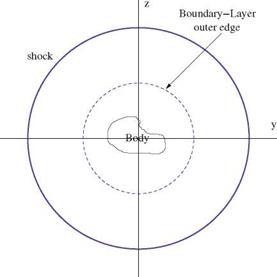Hypersonic Area Rule
An interesting “area rule”, similar to transonic area rule, was introduced by Ladyzhenskii [150]. Following the discussion of Hayes and Probstein [2] and of Cheng [151], Ladyzhenskii showed that two slender bodies with blunt noses will have the same axial pressure distributions and the same drag under the following conditions:
(i)
 |
 |
the drag due to the blunt nose is the same for the two bodies,
(ii) the equivalent body will be within the entropy layer,
(iii) the cross section distribution is smooth.
Other variant requires the nose parts of equivalent bodies to have the same shape. The analysis is based on the assumption that the transverse pressure gradients in the entropy layer may be neglected for slender bodies with blunt noses and asymmetric shapes or at small angle of attack. It follows that the outer field must be (almost) axisymmetric.
A stronger form was discussed by Cheng [151], where only a limited part of the entropy layer is affected by the asymmetric after body (see Fig. 12.17).
Ladyzhenskii treated another type of area rule based on the assumption that є = (Y – 1)/(Y + 1) « 1.
The rule is based on Chernyi’s formulation for M0 = <x>, where the pressure is constant across the entire shock layer. Experiments carried out by Krasovskii [152] to correlate the drag of equivalent bodies indicated that blunting can indeed lower the drag slightly (compared to sharp cones), while the yawed body data showed a reduction in lift as large as 60 % for M0 = 18 and Re = 106.
Strictly speaking, the rule implies no lift and no moment. Indeed, slender bodies at hypersonic speeds suffer from a serious aerodynamic control problem.













